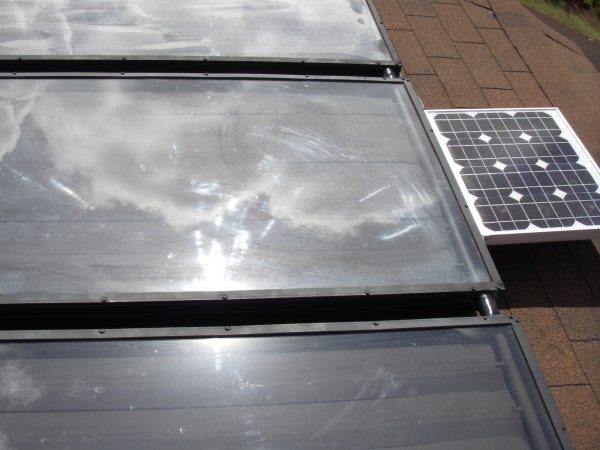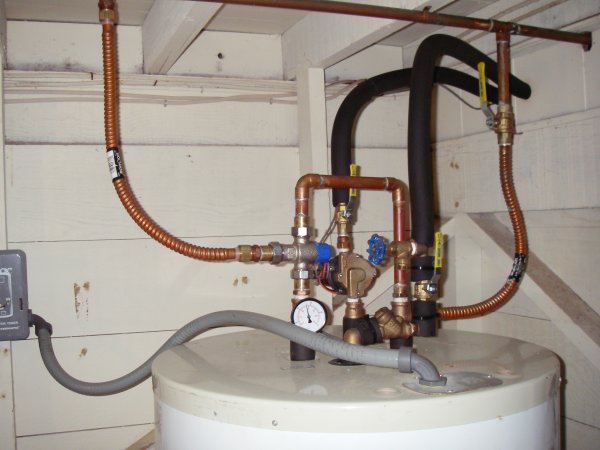We finally had a solar hot water system installed in July, and I’m finally getting around to writing about it.
Solar hot water is just a no-brainer in Hawaii. Electricity and propane cost 2-3 times as much as the mainland, and we probably receive 2-3 times as much solar radiation (I don’t have the exact figures) for free. New systems cost $5-7,000, and used equipment such as ours was only $3,000, but there is a 35% State income tax credit, and 30% Federal tax credit, so the system pays for itself in less than 2 years. After that it’s free hot water for 15-20 years.
We had an old 40 gallon (150 liter) gas water heater that worked, but it wasn’t vented properly, so we knew since we bought the house two years ago that we wanted to replace it with a solar system. One of the installers on the island was selling second-hand systems that he removed from an army base on Oahu (many of the units needed maintenance on one part, so they replaced them all—I won’t criticize the army this time because taxpayer loss is my gain). So we now have a 120 gallon (600 liter) tank with three panels measuring 3’x8′ (0.9×2.4 m) each, or 72 sqf. (6.7 m^2) in all.


In the first picture you can see a photovoltaic panel above the hot water panels. It generates electricity to run the pump that circulates water from the tank up to the panels. I really wanted this option because it avoids having temperature sensors and a microcontroller running an AC pump. The DC pump runs for free when there is enough sunlight and therefore heat, plus it will keep the panels from boiling over during a daytime power outage. The one problem is that I suspect the PV output current is not quite calibrated, so it circulates water too early before the panels are hotter than the water remaining in tank. Maybe I can fix that with some resistors (anyone with electrical knowledge please feel free to leave a comment with the right way of fixing it).
In the second picture, cold water arrives through the copper pipe on the right. The pump is behind, and hot water returns from the roof in the other insulated pipe. Hot water goes to the house through the thermometer and out the copper pipe on the left. The other option I wanted is a thermostatic mixing valve that you see above the thermometer. It mixes cold water with the output of the tank to keep the water from scalding. The gray conduit is the electricity for the backup heater element.
So how well does it heat water? Well, we’ve never had to turn on the electrical backup heater, but there’s only been one day without sunshine so far this summer. In July and August, the tank would heat up to 130-140F (55-60C) and cool down to about 100F (38C) after usage and heat loss by morning. Now in September, the tank is actually getting over 150F (66C) each day because the sun is closer to the angle of the roof where the panels are (the summer sun would be more intense, but it strikes at an angle from the north). That’s another nice self-regulating feature of the system that keeps it from over heating.
Hi Andy,
I was searching for some articles on Kokee and came across your site. What a treat! I’m a former Kauai resident now living in Italy, but I always love to promote my true “home”. Hope you don’t mind, but I’m linking your site to mine so that other’s can learn a little more about the islands. Aloha!
I am buying house in Kauai, need system. Who was the contractor?
Hi Bev, our contractor was Solar Engineering & Contracting out of Kalaheo. Paul Lucas did the estimate himself, and then his crew came do to the installation. They did good work, made sure the pipes weren’t visible on the outside of the house, and I’ve been happy with the system ever since. If I recall correctly, the only thing I had to do was find something to place the water heater on, in my case some packs of shingles.
The electric pump I mention in the article did fail under warranty almost a year later, so they replaced it at no charge. Something was definitely wrong with the old one, because the new one seems to pump at the right times.